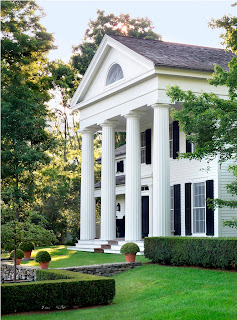Here in Atlanta, we finally got a taste of fall a few days ago. With nightly temperatures hovering in the 30s, it was time for my pretty potted geraniums to come indoors. Unfortunately for them, though, they went from a comfortable balcony to the floor of the kitchen, the only spot that I could find for them where they would get sun. And because I do find geraniums to be a genteel plant, they really have no business being unceremoniously dumped on the floor.
I could always find a narrow table like the one in the illustration above, one on which I could park a few plants, but the problem is that such a table takes up space, something in short supply around my home. What I want, and think that I need, too, is a good old-fashioned plant stand, one dignified enough for geraniums, not to mention my living room as well. Of course, what I covet is a stand much like that owned by the late John Fowler, seen immediately below this text. That has to be the all-time best looking plant stand that I've ever seen.
While looking for other photos of plant stands, I realized that the best examples I could find were featured in books on English and Irish design. Not surprising, really, as a pretty stand holding a flowering plant seems made for both quaint country cottages and grand country houses alike.
For all of you who are being affected by Hurricane Sandy, please stay safe and be well!
John Fowler's stand in the hall at his Hunting Lodge.
A plant stand in Lady Gunston's drawing room in Pelham Crescent, decorated by John Fowler.
A wire plant stand on a table in Fowler's home-showroom at 292 King's Road.
A modern scheme includes a column supporting a potted urn, decorated by David Mlinaric.
A stand with what looks like a terrarium on top, in an 18th century lodge decorated again by Mlinaric.
The charming and much-photographed living room of the late Mark Hampton. The curvy plant stand in the window held a pot of pretty paperwhites.
A fountain converted into a plant stand, at Killadoon, County Kildare
And a Victorian looking stand at Birr Castle, County Offaly.
Image #1 and #7 from Colefax and Fowler: The Best in Interior Decoration
















































